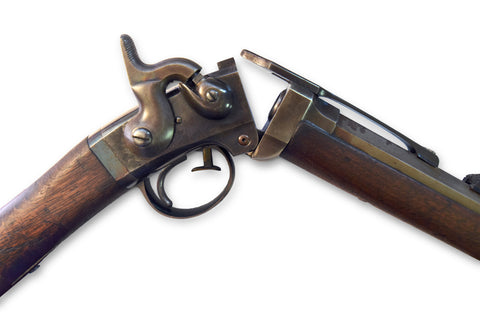
Buttermilk Falls Blaster: The First and Only Carbine That Used Rubber Cartridges
A place named Buttermilk Falls doesn’t sound like it should be associated with a deadly firearm, but that New York town was the home of Gilbert Smith, inventor of a .50-caliber breechloading carbine he patented in 1857 that bears his name.
In 1860, the Washington Arsenal Ordnance Board tested the carbine and was impressed with its ease of loading and accuracy, recommending “it be adopted….”
Many Northern troopers liked the Smith. The 10th New York Cavalry, for example gave it high marks for its durability and ease of use. But others complained that the external spring that held the breech closed was sometimes made of inferior metal, and could break and render the gun useless.
In 1860, Raleigh Colston, then a Virginia Military Institute professor who would become a brigadier general in the Confederate Army, tested the gun for his school and found that after 60 shots the Smith “clogged up so that it could no longer be worked.”
Despite its flaws, more than 30,000 Smith carbines were issued during the war, and it was the fourth most widely used carbine in the Union arsenal.
A portion of Gilbert Smith’s June 23, 1857, patent
drawing for his breechloading carbine. It’s interesting to note that while the
U.S. Army was very conservative when it came to arming infantrymen, providing
the vast majority of the rank and file with single-shot muzzle loaders, the
opposite was true for the mounted arm. Multiple types of breechloaders, and
even some repeaters, were issued out to Federal cavalry regiments.
A Union cavalryman with his Smith Carbine snapped
into his sling, and at full cock. Though the weapon was a breechloader it
still used a percussion cap for ignition. The spark from a snapped cap passed
through a hole in the base of the cartridge to ignite the powder charge. You
can just make out that hole, the dark spot in the center of the base, in the
right cartridge below.
Smith also patented cartridges
made of hard rubber, like the excavated example from Virginia, left, for his
carbine. The rubber helped prevent gas blowback, but casings became sticky and
hard to extract when the gun got hot. In December 1863, a new version of the
cartridge developed by Thomas Poultney of Poultney & Trimble was issued that
used a brass case wrapped in paper, right, which helped seal the breech.
The Smith Carbine is light and
easy to handle at 39 inches long and 7 ½ pounds. The wooden forestock helped
mounted men maintain a grip on the gun after the barrel had heated up from
firing. Early models of the Smith used a traditional sling like those found on
shoulder arms, but that proved impractical. Most Smiths, therefore, were made
with a ring to attach to the standard-issue cavalry carbine sling.
Pop! Pop! Watch a Smith Carbine fire.
See our demonstration of an
original Smith Carbine being loaded with .50-caliber bullets and fired at a
target.
